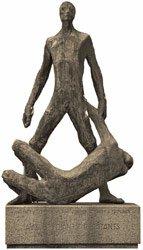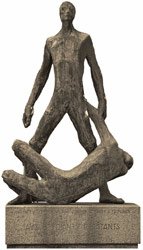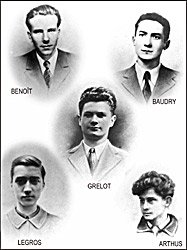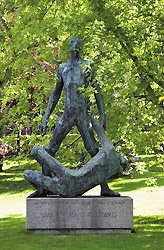The five students from the Buffon high school

Source: SHD
(Shot in 1943) Some high school pupils against Nazi Germany On the 22nd June 1940, following the defeat of France and the signing of the armistice, a high school in the 15th district of Paris, the "Lycée Buffon", became involved in the fight against Nazi Germany. Teachers and pupils dared to defy and demonstrate against the occupying forces. Five of them, whose ages ranged from fifteen to eighteen, augmented the acts of resistance. Wanted by the Gestapo as dangerous terrorists, the five students from the Lycée Buffon were finally arrested and then executed in February 1943. I - 1940 / 1941: the Lycée Buffon joins the resistance movement June 1940 - Paris and part of France are in the hands of the Germans
The armistice was signed on the 22nd June. However, not all French people accepted it. Some, responding to General de Gaulle's "Appeal of the 18th June", managed to get to England, whilst others chose to continue the fight at home. Pockets of resistance were formed and both mass and individual acts of resistance became more and more frequent. In the Parisian universities and schools, the new term began in an atmosphere of muffled opposition. Pamphlets calling people to join the struggle began to circulate and anti-German slogans appeared on walls. At the Lycée Buffon, as in other establishments, a resistance movement began to take shape among both pupils and teachers.
This same impulse to act and fight by any means against the Nazi occupant was what motivated the five pupils of this establishment in particular: Jean-Marie Arthus, 15 years old in 1940 Jacques Baudry, 18 years old in 1940 Pierre Grelot, 17 years old in 1940 Lucien Legros, 16 years old in 1940 By distributing pamphlets and sticking up posters, these five pupils spread the word amongst their school friends. They tried hard to make them understand that the war was not over and that they had to fight against the occupying army. They took pseudonyms: Marchand, André, Francis, Paul and Jeannot, setting up a small printing press in the The police services became concerned about the activities of these young people, whose identity was as yet unknown.
11th November 1940 - The students dare to defy the Nazi occupant Since1922, the French Republic had officially celebrated the 11th November in commemoration of the signing of the armistice on the 11th November 1918, i.e. at the end of the hostilities of the First World War (1914-1918). As the 11th November 1940 approached, despite the ban by the German authorities and the police department, a patriotic demonstration was organised at the Arc de Triomphe. The pupils from the Lycée Buffon were present in the procession of students who came to lay flowers on the grave of the Unknown Soldier (i.e. the anonymous representative of the foot soldiers of the Great War). 1941 - The students step up their acts of resistance During 1941, resistance groups and networks increased. The number of attacks and sabotages increased against the Nazi occupant, whose repression measures intensified. On the 11th May 1941, the students from the Lycée Buffon were amongst the crowd that paraded in front of the statue of Joan of Arc in the Place des Pyramides. During the winter of 1941, the five fellow students decided to become even more involved in the armed resistance. They joined the resistance movement that would give birth to the "Francs-Tireurs et Partisans Français". III - 1942 / 1943: the repression of the students from the Lycée Buffon April 1942 - The students go into hiding In April 1942, Professeur Burgard, a teacher from the Lycée Buffon and the head of the "Valmy" resistance movement, was arrested in his home by the Gestapo. The reaction of his pupils was instant. They decided to protest publicly. During the Easter holidays, they organised a demonstration which took place at the start of the new term on Thursday 16th April 1942. On this day, during morning break time, around fifty pupils from other establishments brought by Lucien Legros, broke into the Lycée and joined the Buffon group, led by Pierre Benoît. Jean-Marie Arthus, Jacques Baudry and Pierre Grelot were given the task of keeping watch and raising the alarm in the event of danger.
For ten minutes, pamphlets were handed out and appeals made. The pupils began to disperse when the bell rang, but an agent in the Lycée had already closed the exits and warned the police. The five ringleaders managed to escape. Lucien Legros and Pierre Benoit, were now wanted as "very dangerous young people" and forced to live in hiding. Far from ceasing, the work of the five friends intensified. They took part in attacks on German officers, launching grenades against a German admiral and his guests during a reception held on a boat on Seine. They slipped pamphlets under doors and stuck up posters etc. accomplishing all these gestures, both "small" and "great", that contributed to sapping the morale of the occupant and maintaining a climate of insecurity. June1942 - Some students are arrested and handed over to the Gestapo On the 3rd and 4th June 1942, four of them were betrayed and arrested. Only Pierre Benoît managed to escape. On the 17th June 1942, Lucien Legros, Jean-Marie Arthus and Pierre Grelot appeared together in front of the special court in Paris charged with participating in a demonstration organised in Rue de Buci in the 6th district. The three young people were each given a life sentence of hard labour without the possibility to appeal. They were then handed over to the Gestapo, along with Jacques Baudry, who had also been involved in attacks on occupying troops. Pierre Benoît, who was still at large, was sentenced to death in absentia. At the head of an FTP group, he carried on the struggle under the pseudonym "L'Étudiant" (The Student). Based with his team in Fontainebleau, he directed sabotage operations on railway tracks and aerodromes. Wounded by a bullet during an operation, he made his way to Paris on foot for treatment. Reported to be a highly dangerous terrorist leader, he was actively sought throughout France. August 1942 - The fifth student, Pierre Benoît, is arrested On the 28th August 1942, Pierre Benoît was arrested near Saint-Lazare station and joined his school friends in La Santé prison.
October 1942 - The five students are sentenced to death On the 15th October 1942, following a new trial, the five resistance fighters were sentenced to death by the court of the Luftwaffe and transferred to Fresnes prison. They continued their action even from inside the prison, where they tried to win over their guards. They refused to receive a visit from the German chaplain, since he wore the SS uniform. Considered to be rebels, they were banned from receiving mail and visitors. Jacques Baudry and Lucien Legros tried twice to escape, but they were caught at the last minute inside the outer wall and put in irons. February 1943 - The five students from the Lycée Buffon are executed by the Nazis On the 8th February 1943, the five students were shot at the firing range in Issy-les-Moulineaux and buried in the cemetery in Ivry. The night before his death Was the shortest of his life The idea that he was still alive Burned the blood at his wrists The weight of his body sickened him His strength made him groan It was in the depths of this horror that he began to smile He did not have ONE SINGLE school friend But millions upon millions To avenge him and he knew it And the day broke for him. Poem by Paul Éluard, a friend of the Legros family, in tribute to Lucien and his school friends, 1944.
DISTINCTIONS The services of Jean-Marie Arthus, Jacques Baudry, Pierre Benoît, Pierre Grelot and Lucien Legros were officially recognised by the Ministry of the Armies, who awarded them the grade of officer. The five students were decorated posthumously. Legion of honour War cross Medal of the Resistance. Citation on the Order of the Nation.
Citation on the Order of the Nation: Jean ARTHUS, Jacques BAUDRY, Pierre BENOÎT, Pierre GRELOT, Lucien LEGROS Glorious children of France, who, during the occupation, formed the group "The Five Students of the Lycée Buffon", proved themselves in all circumstances to be driven by the purest and most effective patriotic faith. THEY DIED FOR FRANCE Shot on the 8th February1943
To find out more: Poiron Gérard, "Les cinq martyrs du lycée Buffon" (The five martyrs of the Lycée Buffon), in issue no. 16 of the Bulletin de la société historique et archéologique du XVe arrondissement de Paris (Report on the historical and archaeological society of the 15th district of Paris), autumn 2000. Les cinq lycéens de Buffon (The Five Pupils of Buffon) and Buffon, un lycée de la Résistance (Buffon, a school of the Resistance movement), brochures published by the Lycée, 1988.

Cover of edition no. 31 of the "Mémoire et citoyenneté" pamphlet .
Source: SHD

The five pupils of the Lycée Buffon. Source: SHD

Monument erected in Paris, in the Luxembourg Gardens, in tribute To the student resistant fighters. Source: SHD

